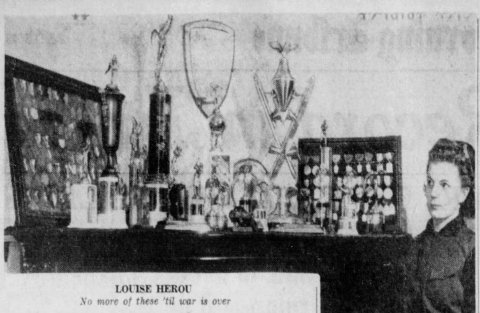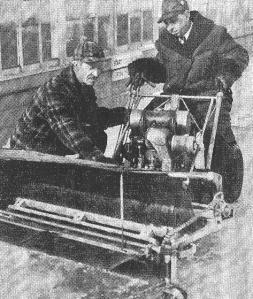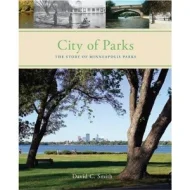Archive for the ‘Speed Skating’ Tag
1948 Olympic Speed Skating Team and Louise Herou’s Medals
As I mentioned last week, a new book out on Twin Cities sports includes a chapter on speed skating. The chapter introduces Minnesota speed skating history from John S. Johnson’s world records in the 1890s to the many great skaters who raced at Powderhorn Lake into the 1960s.
I was reminded of a photo from Minneapolis park board archives that I featured a few years ago. The photo had no caption and I wondered who were the skaters and starters on the ice at Powderhorn Lake. Thanks to several readers, we identified all the skaters and Hubert Humphrey, Minneapolis’s Mayor, next to the starter. The skaters are six of the eight men who won places on the 1948 U.S. Olympic team that skated at San Moritz. No one, however, identified the man with the starter’s gun.

I finally found the original of the photo and it’s not a park board photo after all but a photo by Bud Jewett in the Minneapolis Tribune, February 17, 1947. The original photo also included the famous coach of the Powderhorn skaters, Oscar Johnson. Below is the original published photo with caption, which identifies the man with the gun as Minnesota Governor Luther Youngdahl.

Another bit of skating news: I recently acquired a collection of 110 medals, including national championship medals, won by Louise Herou from 1934-1942. Herou won medals from when she was 13 until she stopped skating after having two seasons cut short by illness. When the 1943 skating season rolled around she was a true-life Rosie the Riveter working at the Twin City Ordnance plant and no longer had time for training. She would never return to speed skating, except as a teacher and coach.

Herou with her medals and trophies from a March 9, 1943 Minneapolis Tribune article on her giving up skating for work at an ordnance plant. Many of these medals were displayed in a new case (below) which I recently acquired.
By then she had become one of the the top golfers in Minneapolis and had made an appearance as a swimmer with the Aqua Follies, the annual water show associated with the Minneapolis Aquatennial. She was also a crack shot with a shotgun, played an excellent second-base in softball and was a top-level tennis player. In 1945 she was inducted into an honorary sorority at the U of M for achieving straight A’s as a freshman. She went to law school at the U of M, became an attorney and married Charlie Saunders who owned Charlie’s Cafe Exceptionale, a leading Minneapolis restaurant, which she continued to run after he died.
The display I acquired has an oak frame with a bronze nameplate that reads “Louise Herou Saunders”, so the medals in the top picture were likely put in this new display case after she was married. Many of the medals are beautifully made by some of the top silver and goldsmiths in the country. Unfortunately, the display was not covered with archival glass to protect the ribbons from UV rays (perhaps such a product didn’t exist when the case was made) so they are very faded. Most medals are engraved on the back with event and result; some are inscribed with her name.
All of her 1934 medals, which were won in the “juvenile girls” category, are inscribed “Tee Herou.” I assume that was a nickname. A check of newspaper results for her skating years reveals that these 110 medals are not nearly all that she won, but include many of her wins in the more prestigious local and national tournaments. While many of the medals she won are missing there is also one from the Minneapolis Star Journal in 1939 inscribed as a Medal of Merit for “Mens Skating.” How that came to be in her collection might be a good story. Where the trophies pictured in the newspaper photo above ended up is anyone’s guess. Louise Herou and Charlie Saunders did not have children.
I’m not really a collector of such things as these medals, but when I saw them for sale I thought they should remain together as a collection instead of being sold off individually. Herou’s scrapbooks are in Special Collections at Hennepin County Library. Perhaps a skating or historical organization will some day want to display her medals. If not for WWII, it is quite possible she would have competed on an international stage, although not the Olympics. Women’s speed skating wasn’t an Olympic sport until 1960.
David Carpentier Smith
Twin Cities Sports History
I’m happy to alert you to the publication of a new book that many of you will enjoy. Twin Cities Sports: Games for All Seasons, edited by my friend Sheldon Anderson, was released yesterday by the University of Arkansas Press. The book presents many of the most interesting aspects of sports in Minnesota history. It provides a behind-the-headlines look at sport and society. I can guarantee everyone will learn something new about sports history in Minnesota.
Dick Dahl writes about pro football, Stew Thornley about the Minneapolis Lakers, Tom Jones about golf — just three of the nine chapters. I think you’ll also enjoy reading about Minneapolis park history from someone other than me in Shannon Murray’s excellent chapter on the creation and evolution of the park system. 
I contributed a chapter on the history of Twin Cities speed skating in addition to collaborating with Shel on chapters about high school basketball and high school hockey. I am especially proud to have written the first broad account of speedskating in Minneapolis and St. Paul, from early superstars like John S. Johnson to the great skaters that came out of the Hippodrome Skating Club in St. Paul and Powderhorn Park in Minneapolis. While researching that chapter I learned so much about extraordinary athletes who have never gotten the attention they deserve. There is so much more to tell. Might be worth a book in itself someday!
Here’s my brush with greatness in the book: we illustrated the basketball chapter with an action photo of Lindsey Whalen in high school. I remember playing in the same gym in which that shot was taken. How cool is that? I bet there’s fewer than six degrees of separation.
The Roseau high school hockey cheerleaders also talked with me and a friend at the lunch counter in the old W.T. Grant’s store on Seventh Street in downtown St. Paul during the state hockey tournament one year when I was a kid. They must have thought we were cute little kids. We were probably staring at them. We were star struck. When you grew up on the East Side of St. Paul hockey was a big deal, so Roseau hockey cheerleaders were nearly celebrities. They were on tv!
I hope you will pick up a copy of the book. Of course, it’s available on Amazon, but I would encourage you to shop at local booksellers when you can.
David Carpentier Smith
Minneapolis Speed Skating Update
The articles I’ve posted on speed skating have been among the most widely read of all topics I have covered. Many readers also have added comments that are full of interesting information and reminiscences. So I would encourage anyone interested in the history of speed skating in Minnesota, especially at Powderhorn Park, to revisit those posts to catch up on the latest info. (Click on “Speed Skating” under “Popular Tags” at right for a list of articles.)
Along those lines, I got a recent note from Patrick Fitzgerald that the description of the photo of the 1948 Olympic team was correct even though it was taken in February, 1947. The 1948 team was selected based on results of the National Championships the year before.
Bob Fitzgerald was the first man named to the 1948 team as a result of his winning the Senior Men’s National Championship in January, 1947, a repeat of his 1946 title. Both times he edged out Ken Bartholomew, another Minneapolitan, for the title.
A reader sent me a copy of the 11 x 14 photo above of an unknown skater, which he had found at a local garage sale. He purchased the photo as well as the size 10 Riedell skates the man in the photo was wearing. We believe he is wearing the uniform of the Bearcats from around 1950. Can anyone identify the skater?
I hope to have more recollections of the Powderhorn skating scene from the 1940s sometime this fall.
David C. Smith
© 2014 David C. Smith
Another Elite Powderhorn Park Speedskater
I’ve written before about the world-class speedskaters who skated at Powderhorn Park in the 1940s and 1950s and the high-level competitions held there. Now reader Gayle Mosiman Meadows has shared more information about speedskating at Powderhorn in the 1930s, especially involving her late father, Roger Mosiman.
She sent this image of a program from a meet in 1938 that featured her father who was then 14.

Program from 1938 speedskating event at Powderhorn Park, featuring photo of Roger Mosiman. (Gayle Meadows Mosiman)
Mosiman was likely featured on the program because at the time he held the juvenile boys national record for the fastest time in the 220 yard sprint. The national record for intermediate boys at the same distance was held at that time by Roger’s older brother, Earl Mosiman. The Bearcat American Legion Post was one of four posts that featured prominently as sponsors of speedskating teams.
Gayle also sent a copy of photo of Roger boarding a train for a skating competition in New York, likely the 1940 North American Speedskating Championship in Schenectady, NY. He is being seen off by his mother, Lillie, and his younger sister, Bernice.

Roger Mosiman boarding a train for the 1940 North American Speedskating Championship in Schenectady, NY. (Photo courtesy of Gayle Mosiman Meadows)
Roger, who attended Marshall High School in Minneapolis, finished the multi-event competition for the junior boys championship tied with Art Bulrice of Saranac Lake, NY. In a one-sixth mile race to determine the title, Roger fell and had to settle for second place. Winning the men’s title that day was future Olympian Leo Freisinger of Chicago.
After Marshall High School, Roger attended the University of Minnesota and became a navy pilot in WWII. In the 1960s, he moved to Gig Harbor, Washington. Roger died there in December 2011 at age 87.
Many thanks to Gayle for the program, the photo and the memories.
David C. Smith
© 2014 David C. Smith
Mystery Starters at Powderhorn Speed Skating Track
This photo is labelled “Olympic Speed Skating Team.” The only date on it is February 16, 1947. That seems too early to have already selected skaters for the 1948 Olympic team. Can anyone identify the skaters? Local skaters Johnny Werket and Ken Bartholomew represented the U.S. at the 1948 Olympics in St. Moritz and Bartholomew won a silver medal. Gene Sandvig and Pat McNamara represented Minneapolis and the U.S. at the 1952 and 1956 Winter Games. (I posted more about those skaters here.) They might all be in this photo.

Can you identify any of these people — skaters and others — at the speed skating track at Powderhorn Park? (MPRB) (Note 9/18: Reader Tom McGrath has identified the starter and the skaters in a comment below. Thanks, Tom and Brian.)
I don’t know the skaters, but I do recognize the fellow in the dark overcoat next to the starter. Anybody know who that is — and what his job was at the time?
I don’t know the guy with the starter’s pistol, but he looks entirely too jolly to be a regular race official. Seems more like a politician holding a noisemaker, but I can’t name him.
Name them all and you get a free lifetime subscription to minneapolisparkhistory.com. (That’s the lifetime of the website, not you.) Be the first to name the man in the dark coat and I’ll email you a free, low-quality photocopy of Gen. John “Blackjack” Pershing’s letter to the Minneapolis park board in 1923 expressing his appreciation for having a park named for him. (More on that story later.)
David C. Smith
© David C. Smith
Minneapolis speedskating: Bearcat 8mm film from 1950s
Adam Martin has posted some fun 8mm film footage of the Bearcat American Legion Post speedskating team in Minneapolis from the 1950s on youtube.
Adam’s father—John—and uncles—Jim, Tom and Michael—skated for the Bearcat team, as he related in a recent comment on my first speedskating post.
Have a look at that post as well as others on speedskating, then click this link (or the youtube.com link in Adam’s comment): http://www.youtube.com/watch?v=c8ewShuJeEo
The first clips were shot at Powderhorn, I believe, but I don’t recognize where the clips at the end were from. Can anyone identify the other rinks featured — or tell us anything else about the clips Adam has provided?
Thanks, Adam.
David C. Smith
P.S. I just heard from Adam that his uncle identified the last clips as being shot in Winnipeg.
Powderhorn Park Speed Skating Track: Best Ice in the United States
Many years before Frank Zamboni invented his ice resurfacer (in California!?), Minneapolis park board personnel had to prepare the speed skating track at Powderhorn Park mostly by hand for international competition and Olympic trials. They were very good at it.
Olympic medalist speed skater Leo Friesinger from Chicago (whom you already met in these pages here) had this to say after he won the Governor Stassen trophy as the 10,000 Lakes senior men’s champion in the early 1940s:
“It is a pleasure for me to return to Minneapolis and skate on the best ice in the United States.”
That was high praise for Elmer Anderson and Gotfred Lundgren, the park board employees who maintained the track at Powderhorn using this sweeper, a tractor-drawn ice planer and a bucket of warm water.

The ice sweeper that cleaned the Powderhorn speed skating track in the 1940s. Elmer Anderson (left) and Gotfred Lundgren kept the track in top shape.
They began to prepare the track 3-4 days before a meet by sprinkling it with water a few times. Then they’d pull out a tractor and a plane—a 36-inch blade—to smooth out any bumps from uneven freezing. The biggest problem was cracks in the ice. So the day before the race, Elmer and Gotfred would spend 8-10 hours filling small cracks by pouring warm water into them.
At times their crack-filling work continued right through the races. When large crowds showed up, and for some races attendance surpassed 20,000, the ice tended to crack more often. If Elmer or Gotfred spotted a crack during a race they’d hustle out with a bucket of water after skaters passed and try to patch it. The sweeper was used to remove light snow from the track.
Elmer and Gotfred, who began working for the park board on the same day 18 years before this picture was taken, agreed that the most speed skating records were set when the air temperature was about 30 degrees, which raised a “sweat” on the ice and produced maxiumum speed.
(Source: an undated newspaper clip in a scrapbook kept by Victor Gallant, the park keeper for many years at Kenwood Park, Kenwood Parkway and Bryn Mawr Meadows.)
It’s no wonder that speed skating (as well as hockey) eventually moved indoors to temperature-controlled arenas. But wouldn’t it be fun to see a big race at Powderhorn again?
David C. Smith
© David C. Smith
Powderhorn Park and Augsburg Stories Converge
A reader of recent posts on Murphy Square/Augsburg College and speed skating at Powderhorn Park put the two together and suggested a link to an article featuring U. S. Olympic speed skater Johnny Werket, who attended Augsburg. From the article we learn that a third Minneapolis park also played a role in the story: Longfellow Field was Werket’s home park.
Thanks for the tip.
David C. Smith
 Comments (2)
Comments (2)






